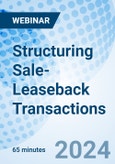Explore the structure of sale-leasebacks and the more creative versions of such transactions.
Operators not wanting to retain capital in real property may look to sell the asset and lease it back from the purchaser at the closing in a so-called sale-leaseback transaction. Retail users, such as banks and restaurants, frequently utilize such transactions. We have also seen sale-leasebacks work for larger users planning a move from the property being sold while retaining the flexibility to have time to do so and generating capital from the first property to move forward with the next property. These transactions include a set of issues that can be viewed as an overlay on the normal approach to each purchase, sale, and lease. Factors include (a) the economics of the transaction as, essentially, an investment transaction, (b) the allocation of risk between the operator-seller which developed the facility, and the purchaser-landlord which will own the property, and (c) the approach to the property upon expiration of the leaseback. Financial creativity has expanded the use of the sale-leaseback structure. There are firms that acquire land to lease to an operator and sell the lease following the completion and opening of the operator’s facility. In other cases, a ground lessee, after developing its facility, may sell the ground leasehold interest with or without the improvements made and lease back the improved property from the purchaser, creating a so-called sandwich position for the investor with its own set of issues and opportunities.
Learning Objectives
- You will be able to define the seller-tenant/buyer-landlord relationship and the respective needs, concerns and goals of the parties.
- You will be able to review how to evaluate and address economic return and risk allocation.
- You will be able to describe land and improvement values as affecting the transaction.
- You will be able to discuss financing a purchase and leaseback, income stream, and credit quality.
Agenda
Speakers

Kenneth S. Kramer,
Nossaman LLP- More than 35 years of experience as a real estate attorney
- Advises major regional developers and investors with diversified portfolios on a full spectrum of office, industrial, recreational, and retail property transactions, including acquisitions and dispositions, leasing, financing, joint ventures, workouts, and alternative energy transactions
- Leasing experience includes: build-to-suit office lease for approximately 150,000 square foot tenant with expansion rights, build-to-suit lease of distribution and office facility of approximately 175,000 square foot project; build-to-suit lease for 400,000 square foot warehouse and distribution facility, and a recent lease renewing, expanding and renovating two office buildings with renovation of common areas and the addition of a third build-to-suite R&D building to the campus (the latter transaction was completed during the COVID-19 pandemic and required modification of the financial structure for improvements)
- Lectures on leasing transactions, build-to-suit leases, and other real estate topics
- Former chair of Nossaman’s Real Estate Transactions Practice Group, and is the current assistant managing partner of Nossaman
- J.D. degree, University of Southern California School of Law; B.A. degree, University of Pennsylvania
Who Should Attend
This live webinar is designed for attorneys, presidents, vice presidents, real estate professionals, developers, controllers, tax managers, CFOs, directors, business owners and managers, and lending professionals.









